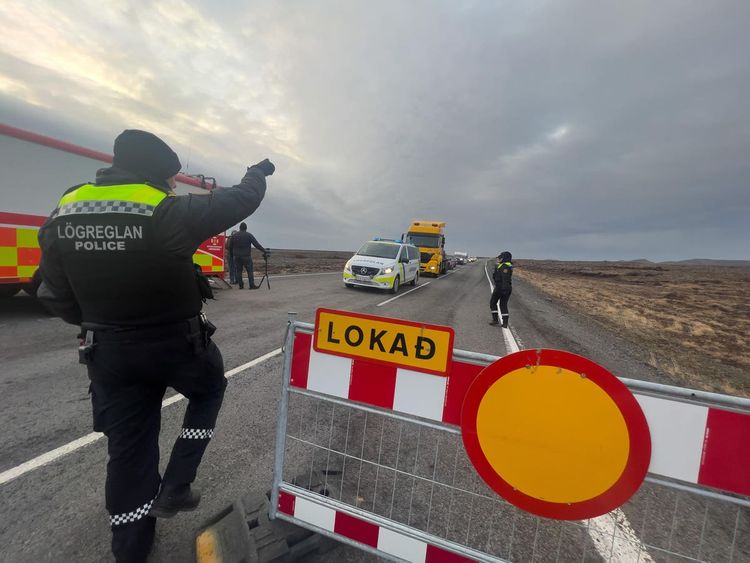How Iceland's Imminent Volcanic Eruption Could Disrupt Travel In ...

Police direct traffic out of Grindavik as Iceland braces for a volcanic eruption. (Photo by Micah Garen)
Getty ImagesOver several weeks, thousands of small earthquakes have shaken Iceland, splitting pavements, spurring evacuations and even shutting down the country’s most popular tourist attraction, as the country braces for the eruption of a volcano within 20 miles of the country’s main international airport.
“The chance of an eruption has increased,” the Icelandic Meteorological Office warned on Friday. “Can start anytime in the next few days.”
Two thousand earthquakes have been recorded in just the last 24 hours. “Most are small earthquakes below 1 magnitude,” the agency wrote in Friday’s update, “but this morning at 6.35 an earthquake was measured at Hagafell with a magnitude of 3.0.”
The Fagradalsfjall volcano on the Reykjanes Peninsula in southwestern Iceland is located near Grindavík, a fishing town around 31 miles southwest of the capital of Reykjavik and just 16 miles from Keflavík airport, the country’s largest airport and the main hub for international flights.
If an eruption is large enough, it could potentially disrupt air travel for days or weeks—and not just over Iceland. When Iceland’s Eyjafjallajökull volcano erupted in 2010, persistent northerly winds carried giant plumes of volcanic ash to continental Europe. Over 100,000 flights were cancelled over several weeks, affecting 7 million passengers and shaving $4.7 billion off the global economy, including $1.7 billion in lost revenue to airlines, according to an analysis by Oxford Economics.
On Monday, the Accuweather Global Weather Center warned of the potential for impacts to air travel over the coming weeks. “Volcanic ash, if ingested in sufficient quantities, can result in jet engine failure – a serious threat to planes,” said Jonathan Porter, AccuWeather’s chief meteorologist. “As a result, during the 2010 eruption, as the ash cloud spread, civil aviation authorities in various countries shut down air travel, resulting in many travelers from Europe and beyond becoming stuck for weeks on end with no ability to fly.”
The Fagradalsfjall volcano is close to Iceland's famed Blue Lagoon as well as its international airport.
Visit IcelandSince Eyjafjallajökull erupted in 2010, the European Union Aviation Safety Agency (EASA) says it is now better prepared for a major volcanic ash event and is monitoring the current Fagradalsfjall situation. “In the event of an eruption and development of an ash cloud, the agency will work with other aviation actors to assess the impact for aviation and make recommendations accordingly,” according to a statement on EASA’s website.
As of Friday, Iceland Air says the ongoing seismic activity in the Southwest region of Iceland “has not affected” flights to or from Iceland. “We are in close contact with Icelandic authorities and are monitoring the situation closely,” per the carrier’s travel alert.
Iceland’s tourism authority is also calling for calm, noting that “Iceland is no stranger to volcanic activity and experiences a volcanic event every five years, on average. Three eruptions have occurred on the Reykjanes Peninsula in the last three years, none of which caused harm to people or disrupted air traffic.”
“It is impossible to predict whether a volcanic eruption will break out, or exactly when or where in the vicinity of Grindavík a potential eruption might break out,” according to an article posted Friday on the Visit Iceland website. “It is important to note that there are currently 46 volcanoes actively erupting around the world, without any major disruption to international air traffic.”
MORE FROM FORBESIceland Travel: Should You Visit Amid Volcano Drama?By David Nikel
Accuweather’s Porter doesn’t believe that Fagradajsfall’s eruption will create the level of severe air travel disruptions seen in 2010, due to differences between the volcanoes. “The Eyjafjallajökull volcano is located at high elevation—more than 5,500 feet—and is essentially covered by an ice glacier,” he said. “When this volcano erupted in 2010, the ash cloud was made more explosive because molten lava interacted with the melting ice cap.”
Still, Porter says the potential for flight disruptions is very real. “The volcano near Grindavík is not encapsulated in an ice cap, but if it erupts, it can still introduce plumes of volcanic ash into the atmosphere, which can travel on the upper-level winds,” he said.





















































